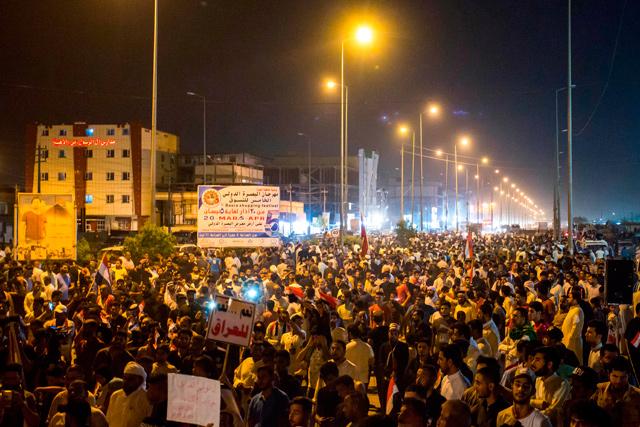You are here
US presence in Iraq since 2003
By AFP - Jan 16,2020 - Last updated at Jan 16,2020

A photo taken on January 13, 2020 during a press tour organised by the US-led coalition fighting the remnants of the Daesh terror group, shows soldiers clearing rubble at Ain Al Asad military airbase in the western Iraqi province of Anbar. Iran last week launched a wave of missiles at the sprawling Ain Al Asad airbase in western Iraq and a base in Erbil, capital of Iraq’s autonomous Kurdish region, both hosting US and other foreign troops in retaliation for the US killing top Iranian general Qassem Soleimani in a drone strike in Baghdad on January 3 (AFP photo)
BAGHDAD — The United States invaded Iraq in 2003 and pulled out after eight years, returning in 2014 to head a coalition battling terrorists.
Amid calls for its 5,200 troops to leave after a US air strike killed top Iranian and Iraqi commanders this month, here is an overview of the US military presence in Iraq.
2003: invasion
The March 2003 US-led invasion is launched after claims that Saddam Hussein's regime is harbouring weapons of mass destruction.
US forces take control of Baghdad the following month.
President George W. Bush announces the end of major combat operations in May.
In October, a US report says no weapons of mass destruction have been found in Iraq.
Saddam is captured in December and hanged three years later.
The broadcast in April 2004 of images of torture and other abuse of Iraqi prisoners at the Abu Ghraib US military prison shocks the world.
Washington transfers power to an interim government in June.
Insurgency, conflict
In November 2004, more than 10,000 American and 2,000 Iraqi soldiers attack the city of Fallujah, retaking it from Sunni insurgents who backed the former regime and extremists.
In February 2006, Al Qaeda-linked terrorists blow up a Shiite shrine in Samarra, sparking sectarian killings that leave tens of thousands dead and last until 2008.
In January 2007, Bush boosts the number of US troops in Iraq to 165,000.
2011: pullout
In December 2011 US President Barack Obama withdraws the last American soldiers.
They leave behind an elected Iraqi government but a population scarred by ongoing violence.
Around 4,500 US troops had been killed in Iraq since 2003; at least 112,000 Iraqi civilians also lost their lives, some caught up in fighting and others in sectarian violence or attacks.
2014: terrorists
In January 2014, terrorists capture Fallujah and parts of Ramadi city. In June, they seize Mosul and by the end of 2014 hold one-third of Iraq.
The United States intervenes by bombarding positions of the Daesh group and deploys troops to train and equip local security forces.
By mid-2015, there are officially 3,500 American troops stationed in Iraq.
With the help of a US-led coalition, Iraqi forces drive Daesh from all urban centres, declaring in December 2017 the "end of the war".
US, Iran tensions
From late October 2019, US interests in Iraq are hit by a series of rocket attacks blamed on paramilitary groups backed by Iran, which has a growing influence in the country.
A barrage of rockets fired at a military base in Kirkuk in December kills an American civilian contractor and wounds several US and Iraqi soldiers.
The US retaliates with air strikes that kill at least 25 fighters from a hardline pro-Iran paramilitary.
An outraged pro-Iran mob lays siege to the US embassy in Baghdad on New Year's Day.
On January 3, President Donald Trump orders strikes that kill top Iranian commander, Qasem Soleimani, while he is in Iraq, as well as a top paramilitary chief.
Furious Iraqi lawmakers demand the expulsion of the 5,200 US troops in Iraq. Washington pauses joint military operations.
On January 16, The New York Times reports that operations had resumed in order to pick up the fight against the Daesh.
On Wednesday, Rouhani had said Iran's missile launches against Iraqi bases used by the US armed forces had provided "compensation" for the death of General Qasem Soleimani, the architect of Iran's Middle East military strategy.
In his speech on Thursday, Rouhani said that the Iranian retaliation — which caused significant material damage but no casualties according to the US military — had strengthened Iranian deterrence against the "threats" of President Donald Trump.
Rouhani, a moderate on his country's political spectrum, also defended the policy of openness to the world that he has pursued since his first election in 2013, and which has come under fire from Iran's ultra-conservatives.
He also defended the 2015 international agreement designed to limit Iran's nuclear programme which has been in tatters since Trump unilaterally pulled out of it in 2018.
Rouhani said that with the nuclear deal "we have proven in practice that it is possible for us to interact with the world”.
"Of course, it's difficult," he acknowledged.
"They tell us: there are people you should not trust," he said, referring to the rhetoric of Iranian ultra-conservatives about Europe and the United States.
"It's true" the Iranian president said, adding that "if there were trustworthy people ... it would be simple and easy" while also referring to Trump as "an unpredictable man".
Related Articles
BAGHDAD — Two mortar rounds hit the Iraqi capital's Green Zone on Saturday and two rockets slammed into a base housing US troops, secur
BAGHDAD — Thousands of supporters of a populist Iraqi Shiite Muslim cleric urged political and factional leaders on Friday to stay out
NAJAF, Iraq Iran’s Hassan Rouhani met Grand Ayatollah Ali Sistani in Iraq’s Najaf on Wednesday, an AFP photographer reported, in t

















